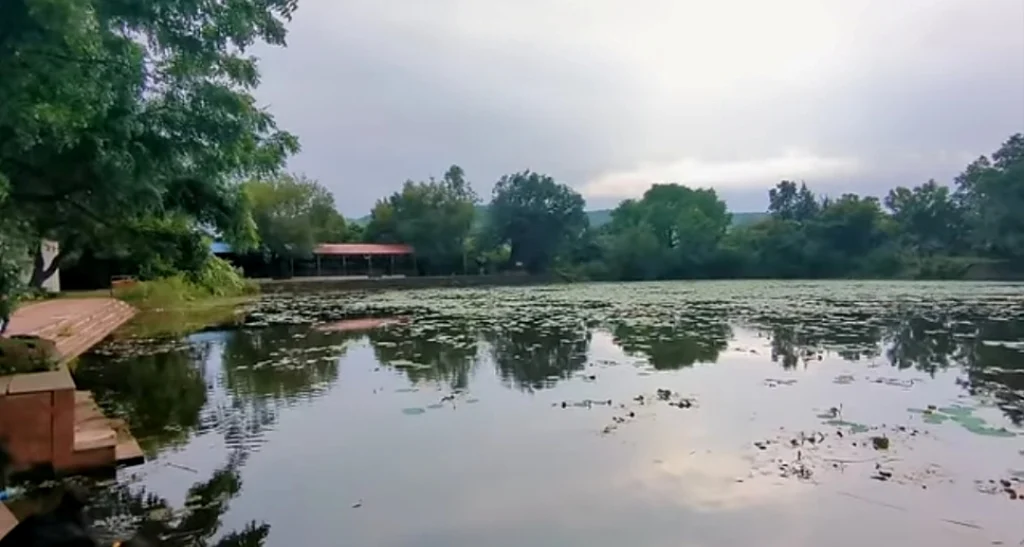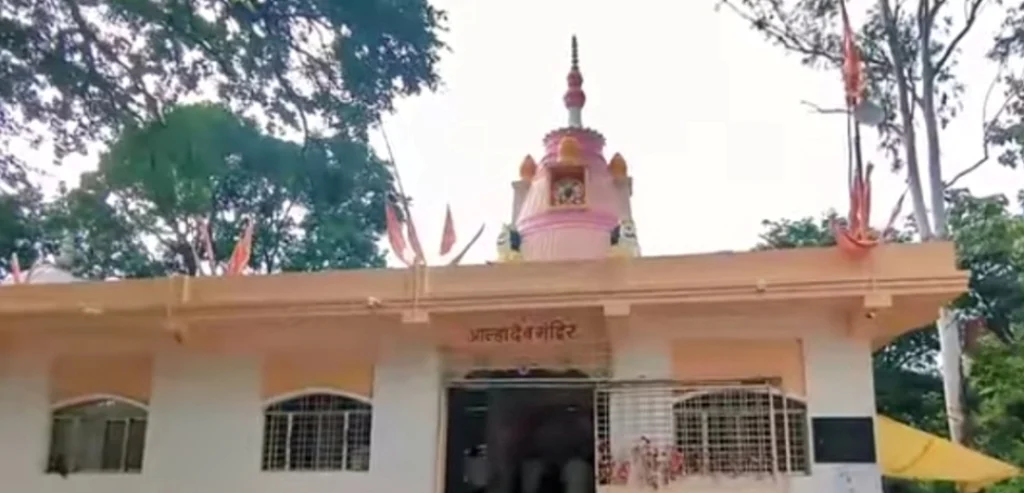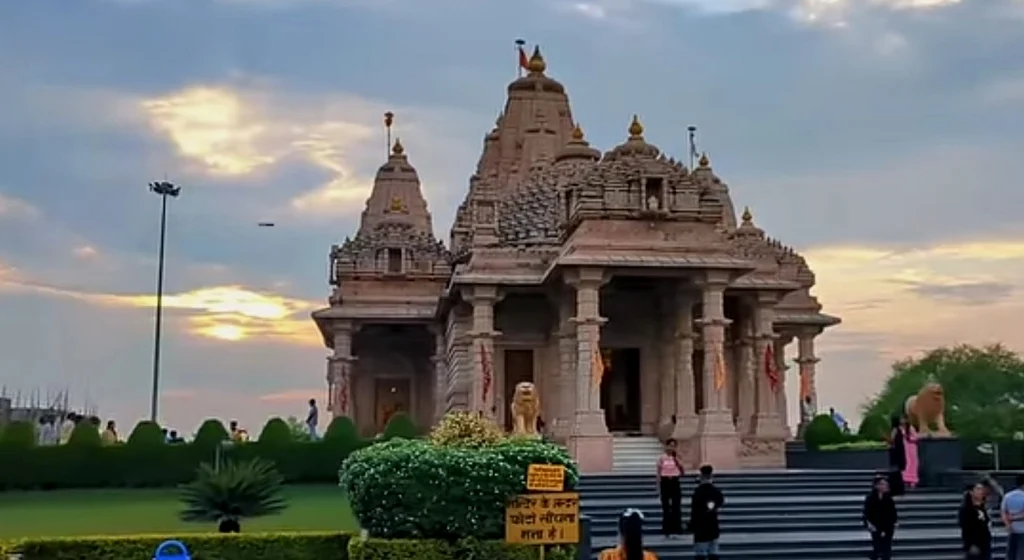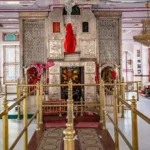The Maihar Devi Temple, also called Maa Sharda Devi Temple, is a famous Hindu temple in Maihar, Satna district, Madhya Pradesh, India. It is dedicated to Goddess Sharda, a form of Saraswati. The temple stands on top of Trikoota Hill and is believed to be one of the 51 Shakti Peethas, where Sati’s necklace fell.
As the legend goes, the temple is the dwelling place of Maa Sharda, believed to be a form of Goddess Durga. With breathtaking views, ancient energy, and an uplifting aura, the temple is not just a religious site but a transformative journey.
Mythological Background:
According to the Hindu Puranas, Sati, the daughter of Prajapati Daksha, married Shiva against her father’s wishes. Daksha performed a grand yajna (sacrifice) but did not invite Sati or Shiva. Even so, Sati went to the yajna, where Daksha ignored her and insulted Shiva. Unable to bear the insult, Sati offered herself into the fire. Filled with grief, Shiva wandered the universe carrying her half-burnt body. At last, Vishnu used his Sudarshan Chakra to cut her body into 51 parts, which fell on different places across the earth. Each of these places became a Shakti Peeth.
Devotees believe that Sati’s necklace fell at Maihar, turning it into one of the sacred 51 spots where her divine energy resides.
The name “Maihar” literally translates to “Mother’s necklace” (Mai = mother, Har = necklace), giving the temple both a poetic and devotional essence. Devotees believe that Maa Sharda grants wisdom and courage to all who seek her blessings.
As time passed, devotees started worshipping Sharda Devi here—a form of Maa Saraswati, the goddess of wisdom. Over centuries, local traditions fused her identity with Durga and Kali, turning Maihar Devi into a fierce yet compassionate mother figure. Worshippers now revere her as both the giver of knowledge and the destroyer of evil.
Local people also speak of the legendary warriors Alha and Udal, who served in the army of King Paramal of Mahoba. Alha, a devoted follower of Sharda Mai, once wandered deep into the forest and discovered the hidden shrine. He meditated for 12 years to gain her blessings. People believe that even today, Alha comes every morning before sunrise to offer prayers at the temple. The priests keep the first offering aside—just for him.
You may also explore four Adi Shaktipeethas: Vimala, Tara Tarini, Kamakhya and Kalighat.
Historical Records:
Maihar Devi Temple doesn’t just rest in legend—it pulses with the rhythm of history. Its spiritual roots reach back to the 10th century, when the Kalachuri dynasty ruled central India. Over time, powerful leaders like Rani Durgavati and the Bundela kings played vital roles in maintaining and enriching the temple. Their contributions helped shape Maihar into the revered pilgrimage site it is today.
One of the most powerful historical connections comes from the Alhakhand, a legendary epic that recounts the lives of Alha and Udal, two heroic warriors. After a fierce battle with Prithviraj Chauhan, the ruler of Delhi, Alha witnessed the tragic death of his brother Udal. The grief of this loss deeply shook him. Instead of seeking revenge, he turned inward. Alha renounced worldly life and chose the path of Sannyasa, embracing spiritual discipline over warfare.
Even more striking is what happened before the battle. According to tradition, Mata Sharda herself guided Alha. Acting on her instructions, he offered his weapon (saag) at the temple. As a symbolic gesture of surrender and devotion, he bent the tip of the blade. That bent weapon, never straightened again, remains enshrined at the temple. Today, it stands as a symbol of divine presence and intervention during those turbulent times.
Moreover, the temple complex preserves physical artifacts linked to the battle, grounding the mythology in tangible history. These relics remind every visitor of the courage, loss, and faith that echo through Maihar’s sacred halls.
The temple has stood resilient through centuries of cultural transitions, invasions, and climatic changes. Interestingly, the famous classical musician Ustad Allauddin Khan, founder of the Maihar Gharana, was a devoted follower of Maihar Devi. He even established a music school here, blending divine spirituality with musical mastery.
Architecture: Simplicity Echoes Sanctity
Unlike grand South Indian temples or the intricate carvings of Khajuraho, Maihar Devi Temple exudes a humble yet powerful charm. The temple structure is built using local stone, and the design is minimalistic—focusing entirely on the divine presence rather than ornamental grandeur.
Inside the sanctum, the idol of Maa Sharda sits adorned in red and yellow silks, her eyes said to be filled with a living gaze. The temple also houses idols of Lord Shiva and other deities, enhancing its sanctity. The atmosphere is charged with devotional songs, the scent of incense, and the echoes of conch shells.
A ropeway system was added in 2009, offering an alternative to the steep climb, especially for senior citizens and differently-abled devotees.
Geographical Location of Maihar Devi Temple
Maihar Devi Temple is located in the Satna district of Madhya Pradesh. Settled about 600 feet above ground level, the temple rests on Trikuta Hill, offering a panoramic view of the vast plains below. Forests and rocky terrains surround the region, adding to its natural charm and isolation.
Coordinates: 24.266°N, 80.761°E
Elevation: Approximately 183 meters above sea level
The serene surroundings enhance the spiritual experience, making the climb not just a physical trek but a soulful ascent.
How to Reach Maihar Devi Temple
Reaching Maihar Devi Temple is easier than ever:
- By Air: The nearest airport is Khajuraho (around 120 km away). Jabalpur Airport (about 160 km) is another option.
- By Train: Maihar Railway Station is well-connected to major cities like Delhi, Mumbai, and Kolkata.
- By Road: Buses and taxis are available from Satna, Rewa, and Jabalpur.
- On Foot or Ropeway: From the base, pilgrims can choose to climb 1063 stairs or take the ropeway ride up the hill.
Where to Stay:
Here are some recommended places to stay near Maihar Devi Temple:
- Hotel Temple View
Type: Budget Hotel
Highlights: Clean rooms, courteous staff, located close to the temple base, offers a scenic view of Trikuta Hill. - Hotel Surya
Type: Mid-range Hotel
Highlights: Spacious rooms, in-house dining, ideal for families and group travelers. - Sharda Devi Dharamshala
Type: Dharamshala
Highlights: Basic amenities at an affordable price, well-suited for solo pilgrims and spiritual seekers. - MP Tourism Guest House
Type: Government Lodge
Highlights: Peaceful surroundings, limited availability, recommended to book in advance.
If you’re visiting during Navratri or other major festivals, make sure to book your accommodation early, as demand is high.
Best Time to Visit:
The best time to visit Maihar Devi Temple is between October and March. During these months, the weather remains cool and pleasant, perfect for climbing the hill.
- Navratri: The temple witnesses its highest footfall during Navratri (March-April and September-October). Special rituals, lighting, and cultural programs fill the atmosphere with divine joy.
- Avoid Summer: The months of April to June can be extremely hot and tiring for visitors.
Local People and Culture:
The people of Maihar are deeply rooted in devotion and hospitality. Most locals speak Hindi and Bundeli dialects. They take pride in the legacy of the temple and the rich musical heritage of the Maihar Gharana.
Folk songs, spiritual chants, and classical music are part of daily life. Many families have generations who have served the temple in various capacities—from priests and caretakers to musicians and vendors. The community celebrates all major Hindu festivals with grandeur and heartwarming inclusivity.
Nearby Places of Attraction:
Alha Talab

It is believed that Alha, a legendary warrior used to bathe in this pond and offer flowers from it to the Maihar Sharda Devi Temple. Local folklore holds that Alha performed 12 years of intense penance, took dips in this pond, and used lotus flowers from it in devotional rituals. Because of his devotion, the Goddess granted him immortality; it’s said he still comes for the first puja before sunrise, long after human memory.
Alha Mandir

The temple is dedicated to the legendary Bundela warriors Alha and Udal, who are credited with discovering the hidden Shakti Peetha of Maa Sharda in the forests of Trikuta Hill, and performing 12 years of intense penance to earn her divine blessing and immortality. Tradition holds that even today, Alha returns every morning at Brahma Muhurta to worship the Goddess—guided perhaps by spiritual reverence rather than physical presence.
Ichchapurti Mandir

The Ichchapurti Mandir, dedicated to Adi Shakti (Goddess Durga), stands inside the KJS Cement Factory premises in Maihar, Satna district. Locally it is often referred to as the KJS Temple. Modeled on the iconic Akshardham Temple of Delhi, it is a strikingly modern structure built in pink stone imported from Banshipaharpur, Rajasthan. Master craftsmen from Jaipur carved intricate florals and mythological motifs throughout.
Conclusion: A Temple That Whispers to the Soul
Maihar Devi Temple is more than just a spiritual destination. It’s a sanctuary where myths breathe, faith speaks, and nature listens. As you climb each step or float above the forest in a ropeway cabin, your heart begins to feel lighter, more connected, and incredibly uplifted.
For those seeking inner peace, divine intervention, or simply a memorable journey, Maihar Devi Temple awaits with open arms and ancient wisdom.
Don’t wait for the perfect time—let Maihar Devi Temple be your next spiritual stop. Whether you go for the myth, the music, or the peace, one thing is certain—you will return with a part of the divine inside you.
Book your travel, carry your prayers, and embrace the journey. Maa Sharda is calling.
FAQs:
The nearest airport is Khajuraho (around 120 km away).
Maihar Railway Station is the nearest.
There are 1063 steps.
The ropeway at Maihar Temple has a one-way ticket for adults priced at Rs.100 and for children (3-12 years) at Rs.50. For a round trip, adult tickets are Rs.150 and children’s tickets are Rs.100.
Maihar is famous for two things – the temple of Maa Sharda Devi and as the work place of Padma Vibhushan Ustad Baba Allauddin Khan.
Morning Darshan/Puja Timing – 5.00 a.m. to 8.00 a.m. Evening Darshan/Puja Timing – 4.00 p.m. to 9.00 p.m. Temple Closing Time – 9.00 p.m. The temple timings may change during special days and festivals.



